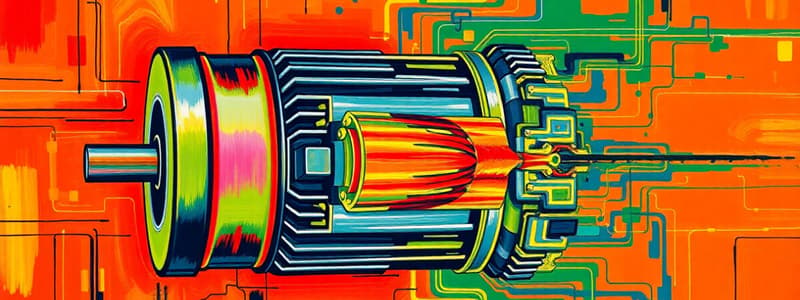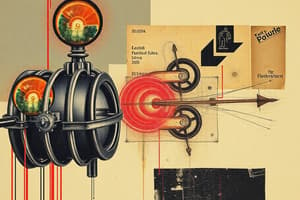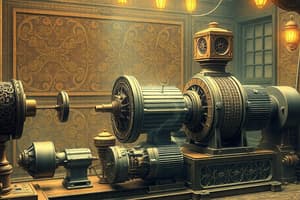Podcast
Questions and Answers
What is a key characteristic of a DC shunt motor?
What is a key characteristic of a DC shunt motor?
- It is classified as a high-torque motor.
- It shows good speed regulation. (correct)
- It operates at varying speeds under different loads.
- It has poor speed regulation.
What can be assumed about the flux in a shunt motor under normal operating conditions?
What can be assumed about the flux in a shunt motor under normal operating conditions?
- Flux remains constant, even under heavy loads.
- Flux can be assumed practically constant, with minor decreases under heavy loads. (correct)
- Flux decreases significantly at all loads.
- Flux increases with armature current.
How does load affect the speed of a DC shunt motor?
How does load affect the speed of a DC shunt motor?
- Speed slightly decreases as load is increased. (correct)
- Speed remains constant regardless of load.
- Speed fluctuates wildly with changes in load.
- Speed increases substantially with increased load.
How does the armature torque relate to the armature current in a DC shunt motor?
How does the armature torque relate to the armature current in a DC shunt motor?
What is the armature current at no load for the 230-V d.c. shunt motor?
What is the armature current at no load for the 230-V d.c. shunt motor?
Which statement about DC compound motors is true regarding motor speed?
Which statement about DC compound motors is true regarding motor speed?
What is the shape of the electrical characteristic curve for a DC shunt motor's torque versus armature current?
What is the shape of the electrical characteristic curve for a DC shunt motor's torque versus armature current?
What is the effect on the speed of the d.c. shunt motor when rated load is applied?
What is the effect on the speed of the d.c. shunt motor when rated load is applied?
In what application would a DC shunt motor be most effective?
In what application would a DC shunt motor be most effective?
What happens to flux in a shunt motor at heavy loads due to armature reaction?
What happens to flux in a shunt motor at heavy loads due to armature reaction?
What is the combined resistance of the armature and field in the motor?
What is the combined resistance of the armature and field in the motor?
What distinguishes a DC shunt motor from other types of DC motors?
What distinguishes a DC shunt motor from other types of DC motors?
Which statement correctly describes the behavior of a DC shunt motor under varying loads?
Which statement correctly describes the behavior of a DC shunt motor under varying loads?
What is the armature resistance of the 230-V d.c. shunt motor?
What is the armature resistance of the 230-V d.c. shunt motor?
At what speed does the d.c. shunt motor operate at no load?
At what speed does the d.c. shunt motor operate at no load?
Flashcards
Shunt Motor Torque
Shunt Motor Torque
In a DC shunt motor, the torque is directly proportional to the armature current.
DC Shunt Motor Flux
DC Shunt Motor Flux
Flux remains relatively constant in a shunt motor, except at high loads where armature reaction slightly diminishes it.
Armature Reaction
Armature Reaction
A phenomenon where the armature's magnetic field affects the main field flux, particularly at heavy loads.
DC Shunt Motor Characteristic
DC Shunt Motor Characteristic
Signup and view all the flashcards
Ta ∝ Ia
Ta ∝ Ia
Signup and view all the flashcards
DC Shunt Motor Speed Regulation
DC Shunt Motor Speed Regulation
Signup and view all the flashcards
Constant Speed Motor
Constant Speed Motor
Signup and view all the flashcards
DC Shunt Motor Speed vs. Load
DC Shunt Motor Speed vs. Load
Signup and view all the flashcards
DC Compound Motor Characteristics
DC Compound Motor Characteristics
Signup and view all the flashcards
Series-to-Shunt Field Ampere-Turns Ratio
Series-to-Shunt Field Ampere-Turns Ratio
Signup and view all the flashcards
No-load speed
No-load speed
Signup and view all the flashcards
No-load armature current
No-load armature current
Signup and view all the flashcards
Rated load
Rated load
Signup and view all the flashcards
Speed drop
Speed drop
Signup and view all the flashcards
Armature current at rated load
Armature current at rated load
Signup and view all the flashcards
Study Notes
DC Motor
- Principle of Operation: A current-carrying conductor in a magnetic field experiences a mechanical force (F = BIL). Fleming's left-hand rule determines force direction. DC motors and generators have the same construction.
- Torque and Back EMF: Armature conductors experience forces due to current and stator field, creating torque. Back EMF (Eb) is generated in the armature due to rotation, opposing the applied voltage (V). Eb calculation: Eb = (POZN/60A). Note that Eb is always less than V.
- Torque Equation: Torque (T) is the product of force and radius (T = F × r). Power developed (P) in the armature is T x ω (radians per second), where ω = 2πN/60. Important relationship is Pa = Ta x ω= Eb x Ia.
- Significance of Back EMF: Back EMF regulates armature current (Ia). When load increases, armature speed decreases, thus Eb decreases. Allowing more current to flow, so driving torque increase.
- Speed of a DC Motor: Speed (N) is related to back EMF (Eb), flux (Φ), and torque (T) N = (Eb / φ) x constant. Speed is inversely proportional to flux and directly related to V and inversely proportional to Ia. Constant speed motors are typically shunt motors
- Classification of DC Motors:
- Separately excited
- Self excited (Shunt, Series, Compound)
- Short shunt
- Long shunt
- Characteristics:
- Shunt Motor: Constant speed, relatively high starting torque, good speed regulation.
- Series Motor: High starting torque, variable speed, very poor speed regulation.
- Compound Motor: Variable speed, high starting torque (cumulative), improved speed regulation.
- Starting of DC Motors: High starting current is typically required to overcome the inertial load, necessitating a starter. A three-point starter limits initial current, and a four-point starter allows for field rheostat control without impacting starting currents.
- Losses and Efficiency: DC machines have constant losses (iron, friction) and variable losses (copper). Efficiency (η) is output/input.
- Speed Control: Speed regulation can be achieved through field control or armature control methods. Field control adjusts magnetic flux, and armature control adjusts armature voltage, used mainly in series motors.
Studying That Suits You
Use AI to generate personalized quizzes and flashcards to suit your learning preferences.




